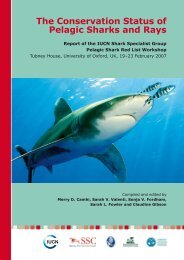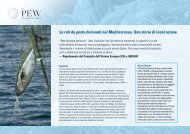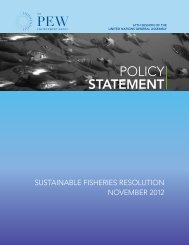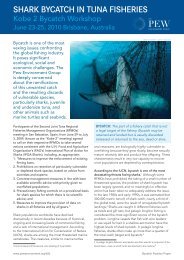The Law That's Saving American Fisheries - Ocean Conservancy
The Law That's Saving American Fisheries - Ocean Conservancy
The Law That's Saving American Fisheries - Ocean Conservancy
Create successful ePaper yourself
Turn your PDF publications into a flip-book with our unique Google optimized e-Paper software.
Bycatch standard proves magnet for ingenuity<br />
Development of risk pools for reducing bycatch<br />
is a major innovation in fishery management,<br />
providing an opportunity for people to make<br />
money in difficult circumstances. Rob Seitz and Glen<br />
Libby are part of a long line of innovators who developed<br />
methods to make fishing profitable within the<br />
constraints necessary to ensure long-term sustainability.<br />
One example of such ingenuity is gear modification. In<br />
the 1970s in the Gulf of Mexico, fishermen developed<br />
gear to remove jellyfish that clogged their nets and<br />
eject protected marine turtles, the catch of which<br />
could have shut down their fishery. That know-how led<br />
to devices such as the Jones-Davis bycatch reduction<br />
device, the top-performing gear for reducing finfish<br />
bycatch in the shrimp fishery.<br />
driven fisheries to a higher level of performance while<br />
pushing innovation in science and management. Despite<br />
protests that implementation of tough requirements<br />
would ruin the fishing business, new rules instead<br />
have promoted innovation, expanded markets, and<br />
built technologies that the rest of the world can use.<br />
Separators allow catching cod without taking halibut,<br />
and trawling for shrimp while minimizing the taking of<br />
juvenile snapper. Other devices deter turtles, birds, and<br />
mammals from bait and catch. Video cameras are now<br />
used for catch monitoring, sampling, and stock assessment.<br />
Cutting-edge technologies employ remotely<br />
operated underwater vehicles, autonomous underwater<br />
vehicles, and other submersibles, all of which are revolutionizing<br />
our knowledge of the ocean and improving<br />
stock assessments.<br />
Conservation and management measures<br />
shall, to the extent practicable, (A)<br />
minimize bycatch and (B) to the extent<br />
bycatch cannot be avoided, minimize the<br />
mortality of such bycatch.<br />
—National Standard 9 of the Magnuson-Stevens Act<br />
Bycatch, which is specified in the national standards<br />
has been a concern to fishermen and managers in<br />
several areas: as waste or discards; as an allocation<br />
issue between fishing sectors, such as catch of valuable<br />
salmon, halibut, or crab in groundfish fisheries; or as<br />
an overfishing issue that hinders rebuilding of species.<br />
In the past 15 years, the Magnuson-Stevens Act has<br />
<strong>The</strong> top-performing Jones-Davis bycatch<br />
reduction device was developed by<br />
shrimp fishermen in Freeport, TX.<br />
Chris Dorsett<br />
28 It’s a Keeper

















